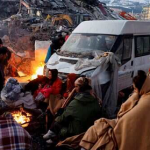The Kahramanmaras earthquake, a massive 7.8 on the Richter scale, struck before dawn on 6 February in southern Türkiye. It has left a trail of death and destruction in 10 provinces in Türkiye and in north-western Syria. Over 47,000 people have already lost their lives and many more are homeless. The plight of the survivors was distressing as they searched for missing relatives in the rubble, struggled to secure food and shelter, and coped with an uncertain future. The World Bank estimates the loss to property and infrastructure at $34 billion for both countries [1],[2] so far, and will be much more.
The tragedy overwhelmed both countries and drew global attention. Turkish President Erdogan called it the country’s largest disaster in a century, more destructive than the Erzincan quake of 1939, which claimed 32,000 lives. Türkiye’s Disaster and Emergency Management Authority (AFAD) reached out for international assistance.
Syria too requested assistance and its diplomats in New York sought the lifting of sanctions, although humanitarian assistance was not usually in the ambit of sanctions.
Prime Minister Narendra Modi responded immediately. Consistent with a civilisational ethos of helping those in need, India expressed solidarity and offered all possible assistance to Türkiye and Syria. Operation Dost, providing humanitarian assistance and disaster relief (HADR) to both countries, was airborne within 24 hours of the quake. In Türkiye, six IAF aircraft deployed three units of NDRF, 150 personnel with sniffer dogs, for search and rescue in Gaziantep province and an IA medical team and 99 officers, established a 30-bed field hospital in Hatay province. The teams returned home immediately after completion of their mandated mission. In Syria, two IAF aircraft ferried medical and relief supplies.
The assistance was appreciated by the people. The rapid deployment of HADR resources burnished India’s reputation as a first responder. Over the last two decades, India has provided HADR support after tsunamis (Aceh, Fukushima), cyclones (U.S.A., the Philippines, Fiji, Sri Lanka, Bangladesh, Myanmar), earthquakes (Nepal, Afghanistan), and other calamities (southern Africa). Evacuation missions from conflict or disaster zones and HADR exercises improved skills and coordination. Today, India has capacity, capability and willingness to undertake HADR missions, in its neighbourhood and beyond.
On the Turkish side, AFAD’s network for relief work was overwhelmed by the scale of destruction. AFAD, Turkish Red Crescent and Türkiye Army teams could reach certain areas only after a few days. On the Syrian side, infrastructure and logistics was weaker and the security situation difficult with rebel groups controlling certain areas. Syrian Red Crescent and White Helmets could initially provide limited support.
Both countries were stressed by economic difficulties and the quake-affected areas were relatively less developed regions. Conflict and internal strife weakened governance, while the influx of refugees and internally displaced persons, owing to the situation in Syria and the Kurdish issue, added to tensions. The internal capacities in Türkiye and Syria were inadequate to deal effectively with the calamity.
The global community responded to the humanitarian tragedy. In Türkiye, teams from over 20 countries joined search and rescue missions, saving lives with their capacities and expertise. On the Syrian side, India and Arab countries provided immediate material support. Subsequently, UN agencies and NGOs reached affected areas from the Turkish side and also with help from Damascus. While international assistance mitigated the extent of human suffering, ongoing regional tensions, sanctions and political issues have delayed relief efforts.
The assistance provided by the global community (allies, friends and those with differing views) was based on humanitarian considerations, rather than transactional diplomacy. However, it opened a window of opportunity for Syria’s normalisation with Arab partners. Prospects for dialogue between Türkiye and potential partners will depend more on other factors and realpolitik. Only the naive will expect a significant change in foreign policy as a response to disaster relief provided, but the goodwill of the people has been established.
The southern edge of the Anatolian plateau, where the quake struck, was at the crossroads of civilisation for millennia. Home to Tigris and Euphrates rivers, it saw the first cultivation of crops, growth of community life and rise of urban centres. Empires ebbed and flowed, the Hittite, Greek, Roman, Persian, Arab and Turk flourished in this unique land – and all had connections with India. This imparted a composite culture with different faiths to the inhabitants, a tradition that continues even today, and deserves support.
India’s humanitarian assistance to Türkiye and Syria, in their hour of need, is consistent with its civilisational ethos, its capacity as a growing power, its capability as a first responder, and its willingness to share best practices with the global community.
Sanjay Bhattacharyya is former Ambassador of India to Türkiye
This article was exclusively written for Gateway House: Indian Council on Global Relations. You can read more exclusive content here
For permission to republish, please contact outreach@gatewayhouse.in
©Copyright 2023 Gateway House: Indian Council on Global Relations. All rights reserved. Any unauthorised copying or reproduction is strictly prohibited.
References
[1] “Earthquake Damage in Türkiye Estimated to Exceed $34 billion: World Bank Disaster Assessment Report,” World Bank, 27 Feb 2023, https://www.worldbank.org/en/news/press-release/2023/02/27/earthquake-damage-in-turkiye-estimated-to-exceed-34-billion-world-bank-disaster-assessment-report
[2] “Critical economic situation for Syrians in the northwest after the recent earthquake, warns the IRC,” ReliefWeb, 20 Feb 2023, https://reliefweb.int/report/syrian-arab-republic/critical-economic-situation-syrians-northwest-after-recent-earthquake-warns-irc


